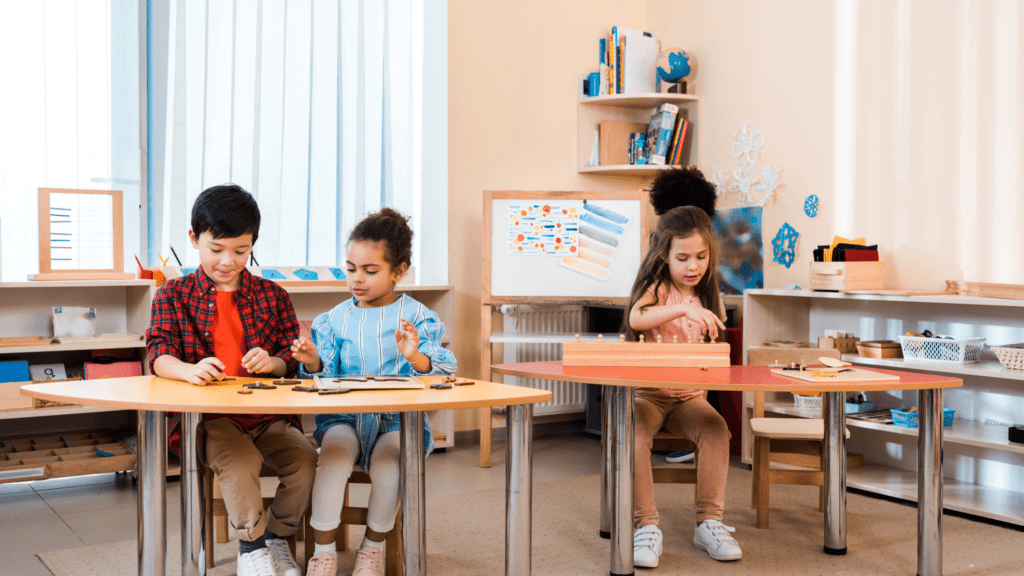How magnificent it must have been that children enter the classroom excited to explore a new material that they have been thinking of? The children hang their bags off, greet their guides, say hello to a friend, and take a moment of transit to set for the exploration. This is what happens in a Montessori classroom. There, a child is provided with a prepared environment, Montessori materials and activities and uninterrupted work periods to fulfill their developmental needs. This all together makes a child’s learning more fun. But how and what do you mean by uninterrupted work periods?
Maria Montessori once said, “When the children had completed an absorbing bit of work, they appeared rested and deeply pleased.”
Montessori schools have a unique approach to learning, which includes an uninterrupted work period. During this period, each child is allowed to complete their chosen activity with no interruption. By this, we mean that a child is allowed to explore the activity or material as long as 2-3 hours. Through this work cycle, Montessori education fosters a child’s independence and helps to develop their critical thinking and problem-solving skills. Isn’t it interesting? Let us learn more about Montessori uninterrupted work periods.
What is the Montessori work period?
The Montessori work period is a period of time during the day in which children are encouraged to do their own independent, self-directed activities. It is a way for children to explore and discover their own interests and passions while also developing skills in problem-solving, critical thinking, and creativity. Children are free to choose activities from the open shelves, they find interesting and engaging and practice important life skills such as self-discipline, focus, and perseverance. This Montessori work period allows children to delve into the activity for as long as 2-3 hrs.
Montessori uninterrupted work periods are also known as work cycles or simply work periods. The Montessori work cycle is known for its idea of independent immersion in a prepared environment, with minimal guidance from adults and giving the child ample time to learn through discovery.
For example, while a child needs to be taught how to cut a banana then, an educator keeps the material ready well in advance for the children. The child comes to the shelf, picks up the banana, and holds it properly in his hands. Next, the child peels the banana properly and places it on a board or plate. Now, the child needs to get a grip of the knife, and it might take from a few minutes to maybe an hour or so for each individual child to hold the knife properly. Montessori Classrooms allow the child to learn the process at his own pace. Once the child is confident to have that grip of the knife, the educator guides them to cut the banana into half or so. To complete this activity, a child may continue the uninterrupted work period for as long as he is interested in exploring the activity with hands.
Work periods give children the autonomy needed for self-directed learning and help them build confidence in themselves as learners. Ultimately, the Montessori work periods provide an invaluable opportunity for children to explore and grow without adult direction–making it one of the most important aspects of a Montessori education.
How does the Montessori Work Cycle Work?
During these periods, which typically last about three hours in the morning, children have the freedom to choose their own work from specially prepared classroom materials. To ensure that all children receive age-appropriate presentations and guidance, an experienced Montessori guide is on hand to provide assistance as needed.
During Montessori work periods, children can choose activities related to math, science, language, art, culture, practical life, and sensorial activities that best suit their interests and abilities. These uninterrupted work periods allow children to set goals and follow through with them without disruption by other activities or noise pollution from outside sources.
The work habits that are formed during this cycle help children to develop a sense of stability and focus on the task at hand. It also allows them to develop their own individual makeup as they repeat and complete works that are meaningful to them. The classroom is structured in a way that helps the whole stabilize and reach an optimal amount of productivity throughout the day. The work cycles include hours of silent activities and some time for play or group activities between each hour-long work period in the morning.
More details on making the Montessori work cycle more productive and utilizing it the best way has been shared in our previous blog The Working of The Montessori Work Cycle
How does Montessori Education Align Uninterrupted Work Periods for Different Age-groups?
In Montessori classrooms, children choose their own work and activities. During the work period, children are presented with materials and activities to foster deep learning connections. Different age groups have varied criteria for uninterrupted work periods.
Infants & Toddlers
In the Montessori classroom setting, each child is responsible for their own learning process and can choose what activities they want to engage in. The duration of these work periods can vary based on age but typically lasts from 10 to 45 minutes throughout the school day for a toddler. As children become more familiar with activities during this time period, they foster a sense of accomplishment as well as an appreciation for the educational materials available in their classroom environment.
Initially, the toddlers are allowed to move through the whole classroom and explore the resources available to them. And are provided with practical life activities such as dressing frames, watering the plants, etc. Here, their concentration may last from a few minutes to an hour.
Early Childhood or primary level or 3-6-year-old children
In the Montessori work period, the children are given the opportunity to work in small groups or individually on activities that range from less prepared activities, such as sensorial materials like thermic tablets, pink towers, and geometric shapes to more prepared activities, such as reading and writing. Work cycles can last anywhere from fifteen minutes up to an hour, depending on the child’s learning ability. Children at this age may engage in “parallel play” (children see what the other children are doing and then modify their play accordingly) and are also focused on their own tasks.
Children in the primary grades often have many work period cycles throughout the day. As the child is in the exploration stage and eager to learn new things, the time frame can range from an hour to three hours. This helps children gain deeper concentration and understanding of every activity. This allows children time for exploration, creativity and self-discipline; all of which contribute to their development in later years.
Elementary level or 6-12-year-old children
The work cycle begins with a morning cycle that starts with the children taking care of their own needs before beginning their chosen tasks for the day. A period of individual or small group activities then followed this, depending on the age level and development stage of each student. After completing these activities,
After this relaxation experience, children will transition into an afternoon cycle where they move on to their next activity based on what was learned during the morning cycle. The afternoon cycle typically consists of more challenging tasks that require more focus and concentration than what was done during the morning session. During both cycles, it is important for educators to keep track of how long each task takes so they know when it’s time for children to move on to something else as well as when it’s time for lunch or nap time.
At the Elementary level, full-class lessons should not take place during the uninterrupted work cycle. Rather, they should be presented before or after the uninterrupted work cycle.
Secondary level or 12-18-year-old children
At the Secondary level, the length of the work cycle varies by setting. Since a child has already gained concrete knowledge, they now focus more on research-based learning. They are encouraged to work independently or in groups during their work period. This allows them to take on complex tasks and prepares them to work in the real world. While engaging themselves in the Montessori work period, the students are able to focus deeply on the tasks they have been assigned, as they are given ample time to complete them.
Many people have found that having this uninterrupted work period helps children stay engaged and motivated in their learning process. Advanced Montessori materials are used to create a stimulating learning environment in which children can receive presentations and guidance from their educators.
Conclusion
The Montessori work cycle encourages a child to be independently immersed in the topics of study. This allows for a simple explanation, without interruption or distraction, to be absorbed more easily by the child. Thus, are the cornerstones of the Montessori classrooms. I also firmly believe that giving a child ample time to learn and explore will help them build a knowledge foundation that lasts for a long.




